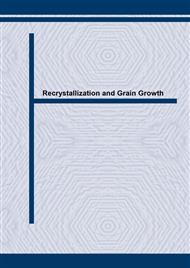p.905
p.911
p.917
p.923
p.929
p.935
p.941
p.949
p.957
Kinetics of Austenite Grain Growth during a Continuous Heating of a Niobium Microalloyed Steel
Abstract:
Grain growth is a thermally activated process in which the average grain size increases as temperature and time increases. The driving force for grain growth results from the decrease in the free energy associated with the reduction in total grain boundary energy. There are several known factors that influence the migration of grain boundaries such as second phase particles precipitated in the matrix and the solute elements segregated at grain boundaries. The austenite grain boundaries are revealed using the thermal etching method. Carbon extraction replicas were prepared to determine the composition and size of precipitates present in the matrix. In this work, the evolution of the average prior austenite grain size (PAGS) of a low carbon steel microalloyed with niobium is studied as a function of temperature and heating rate. Austenite grains show a two-stage growth. It has been found that as heating rate increases, the grain coarsening temperature (TGC) increases and the grain size at that temperature decreases. TGC temperature lies around 40-60°C below the temperature for complete dissolution of carbonitrides (TDISS).
Info:
Periodical:
Pages:
929-934
Citation:
Online since:
October 2004
Keywords:
Price:
Сopyright:
© 2004 Trans Tech Publications Ltd. All Rights Reserved
Share:
Citation:


